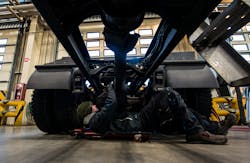Adopting shorter vehicle life-cycles eases technician shortage and reduces costs
It’s easy for the trucking industry to talk about the driver shortage. We’re accustomed to it, the pain touches virtually every component of the supply chain, and, quite frankly, it’s well-documented.
However, there’s another labor shortage that continues to grow within the trucking industry that’s just as alarming to the overall supply chain, although it’s far deeper in the background of the industry: Technician shortage.
Case in point, the shortage of technicians for diesel trucks appeared on the American Transportation Research Institute’s Top Industry Issues Report for 2017. Even though it ranked last among the top 13 challenges listed by survey respondents, it was the first time it made its way into the report.
The problem with a shortage of technicians is that it adds to an already expensive problem the transportation industry has been grappling with in maintaining and repairing trucks. No doubt, older trucks are far more expensive to repair than newer ones, and there are still far too many fleet executives who continue to operate on legacy, outdated philosophies where they try to drive their trucks as long as possible.
The proof is in the data. Even when you factor in the investment costs associated with a new truck, it costs far less to operate and maintain newer trucks, acquired more frequently, as opposed to maintaining the same trucks over a longer period. This is why leasing is less expensive when looking at the Total Cost of Ownership today.
In a recent analysis of actual fleet truck utilization data comparisons, fleets that adopt a three-year, lease-based truck philosophy realize significant savings. Those that replace their trucks in year four realize a savings of $42,830 in M&R alone, calculated in years four through seven when compared to a fleet driving the same truck for the full seven years. A savings of $17,150 is achieved when comparing a three-year lifecycle to a five-year lifecycle.
Calculate these savings over a fleet of a few hundred trucks, and you can see where this represents millions toward the bottom line.
These cost savings grow even larger when you look beyond the typical M&R expenses that include tires, tubes, liners and valves; preventative maintenance measures; brakes; expendable items; exhaust systems; fuel systems; and more.
The older the truck, the costlier the repairs become. What’s more, technician time becomes more expensive, too, because fleets end up requiring more technician time for service. Consider the breakdown of technician time at the average shop:
Five mechanics working eight hours each day equals 40 hours of time inventory every day, 200 hours a week, and 800 hours a month. Subtracting time off for vacations and sick days, the available inventory of time equals 720 hours a month based on an eight-hour day. Typically, 85% of a technician’s time is spent working on a vehicle. 15% is spent administratively (inputting work performed), retrieving parts, cleaning the work area, and any other activity other than working on a vehicle. Now the inventory of available time to work on vehicles drops from 800 hours to 612 hours a month.
Additionally, the hours required to maintain an aging tractor fleet increases every year. On average, a tractor requires two-and-a-half hours each month to maintain in its first year, compared to year three, which requires four-and-a-half hours each month. Therefore, the demand almost doubles but the supply (Labor Hours) remains the same.
All of these costs eat into the bottom line, not to mention create frustrations for drivers, which then exacerbates the ever-growing driver shortage problem. And for an industry that’s now feeling this growing technician shortage, these costs can quickly escalate out of control, not to mention the cost of replacement trucks that sit idle at times. Fleets that adopt a shorter, lease-based lifecycle asset management philosophy can avoid many of these additional costs and headaches.
About the Author
Matt Hendrix
Matt Hendrix, CTP served as senior director of fleet services at Fleet Advantage until 2023. He now works as VP of operational support for Kustom US. Matt has over 20 years of mechanical, operational and fleet management experience.
